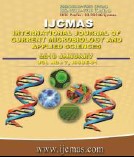


 National Academy of Agricultural Sciences (NAAS)
National Academy of Agricultural Sciences (NAAS)

|
PRINT ISSN : 2319-7692
Online ISSN : 2319-7706 Issues : 12 per year Publisher : Excellent Publishers Email : editorijcmas@gmail.com / submit@ijcmas.com Editor-in-chief: Dr.M.Prakash Index Copernicus ICV 2018: 95.39 NAAS RATING 2020: 5.38 |
Bottle gourd halwa is a popular khoa based traditional dairy delicacy. It is produced on small scale by local sweetmeat makers. In order to commercially manufacture and market bottle gourd halwa, studies on its shelf-life were considered to be very important. Bottle gourd halwa samples prepared using skim milk powder and khoa as base material were packed in polystyrene packaging material and stored at two different temperature i.e. 7±2 °C and 30±2 °C. Chemical aspects with respect to free fatty acids (FFA) and acidity and sensory changes of bottle gourd halwa such as colour and appearance, body and texture, flavour and overall acceptability were monitored during storage period. The FFA and acidity content in bottle gourd halwa increased significantly (p<0.05) during storage and these changes were found to be temperature sensitive. Sensory quality of bottle gourd halwa samples found to be gradually decreased significantly (p<0.05) during storage irrespective of temperature. Bottle gourd halwa samples stored at 7±2 °C and 30±2 °C were acceptable up to 20 days and 3 days, respectively on the basis of sensory attributes.
 |
 |
 |
 |
 |